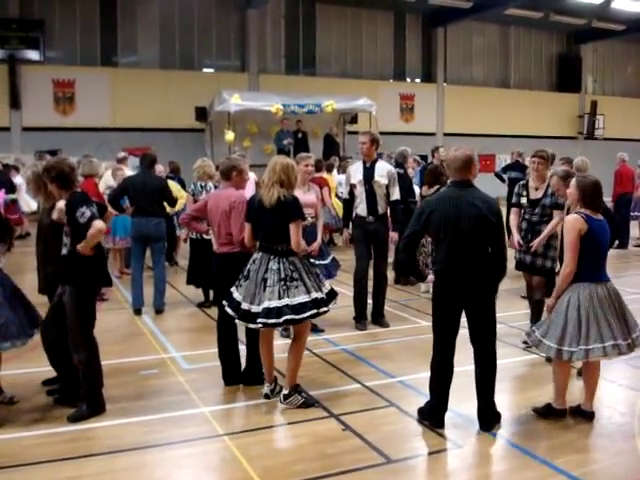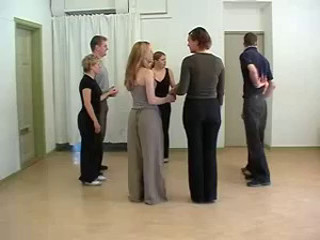
Square Dance
Be there or be square

Be there or be square
 Square Dance is a dance for four couples. At the start of each dance these four couples stand on the lines of an imaginary square facing each other forming the so called “square”. Hence the name: Square Dance. But of course this dance is not for eight persons only. Most of the time several squares are dancing at the same time but independently of each other. A caller cues the dancers through a sequence of steps to the beat of the music, all movements smoothly flowing into each other. While dancing the dancers constantly change their positions and their partners until, at the end of a sequence, they are (or should be) back where and with whom they have started. The order in which the specific dance movements, the calls, have to be danced is up to the caller, so the dancers don't know what the next call will be, making every dance a new challenge for each group of eight dancers. This is what makes Square Dance a dance full of fun and variety, that stimulates your concentrativeness and reactions. The fact that you are not only dancing with one partner, but with a new partner for each dance and with three other couples in a square makes it easy to get to know the other dancers. Best conditions for singles and those of you who like to dance but your partner doesn’t.
Square Dance is a dance for four couples. At the start of each dance these four couples stand on the lines of an imaginary square facing each other forming the so called “square”. Hence the name: Square Dance. But of course this dance is not for eight persons only. Most of the time several squares are dancing at the same time but independently of each other. A caller cues the dancers through a sequence of steps to the beat of the music, all movements smoothly flowing into each other. While dancing the dancers constantly change their positions and their partners until, at the end of a sequence, they are (or should be) back where and with whom they have started. The order in which the specific dance movements, the calls, have to be danced is up to the caller, so the dancers don't know what the next call will be, making every dance a new challenge for each group of eight dancers. This is what makes Square Dance a dance full of fun and variety, that stimulates your concentrativeness and reactions. The fact that you are not only dancing with one partner, but with a new partner for each dance and with three other couples in a square makes it easy to get to know the other dancers. Best conditions for singles and those of you who like to dance but your partner doesn’t.
You never know what the next call will be.
Every dance is different.
Dancers have to know how to react to the call according to their positions in the square.
The dance movements are the same and called in English everywhere, so you can do Square Dance all over the world.
It is astonishing how quickly eight persons, that may not have met before, become a group and enjoy dancing together. Maybe this is because you do not have to memorize a whole choreography and don’t have to remember what movement is next. The caller does that for you. The dancers just have to dance what they are told. A dance round (also called “a tip”) consists of two parts, that is two dances. In the first dance the caller speaks the calls rhythmically to the sound of instrumental music. This part usually contains more challenging figures to be practiced. The choreography often seems unstructured, what makes it challenging for the dancers. This is followed by the singing call. The caller sings the instructions as part of the lyrics of a song and the dancers have to listen closely to discriminate one from the other. Apropos music. If you think Square Dance is all about Hilly Billy Country Music, think again. You can do Square Dance to a wide range of music: Rock, Pop, Punk, Chansons, and of course Country Music. The calls are all in English and the same everywhere. So it is easy to travel and visit Square Dance Clubs and Special Events all over the world.


To learn Square Dance you don´t need special knowledge beforehand, but it helps if you are a good walker and can pay attention while walking. The individual moves are taught in a course that will be held by a Square Dance Club. Before a class starts the clubs often offer an “open house” where you can give Square Dance a try and learn the very first moves. Due to the fact that you will have an other partner for every tip, you don´t have to bring a partner to learn Square Dance. The course, where you will be taught about 70 dance figures, will take approximately 30 to 35 lessons. As mentioned before, Square Dance is international and all calls are in English. But don't worry, the explanations will be given in the local language of your country. A basic knowledge of the English language is advantageous, and makes it easier to understand the meaning of the calls, but is not necessarily needed.
After graduating from the Square Dance Class you might want to join a club to practice your Square Dancing skills on a regular basis. And of course you can also visit other clubs or even take part in Square Dance events.
Find a Square Dance ClubWhat is so interesting about Square Dance is the variety of calls, with each call defining the exact way the dancers have to take within the square. Depending on your position in the square this way may differ a lot and the move thus feels different. If all dancers move according to the definitions the concatenation of several calls result in ever new formations. It is the callers task to arrange the calls and create new sequences so that the dance is always challenging and fun for the dancers.
Here you see the starting position of the eight dancers at the beginning of each dance.
All four couples stand on the lines of an imaginary square. There is an exact definition for each call and by following the cues of the caller the dancers move within the square and find themselves in different formations, e.g. columns, lines, circles.
One of the easiest calls is Pass Thru. Starting from a position where the dancers face each other, the dancers just step forward, passing the opposite dancer on the left.


The call Run is a good example how a dancer has to move in a different way according to his current position and line of sight. Here the directed (active) dancers, e.g. only the ladies, move forward in a semicircle around the person next to them to end in the latter's position. The adjacent (inactive) dancers adjust by stepping to the side into the vacated position from the active dancer without changing facing direction.
 After:
After: 
Depicted you see that the dancers at the end of the line (red / blue) move in a semicircle. In the above line the red dancer moves clockwise whereas the blue dancer moves anti-clockwise in a semicircle, while the dancers in the middle of the line step aside to the left (green) or right (yellow) respectively. In the next line you see that now not only the position within the line has changed for each dancer, but also for the red and the blue dancer the facing direction changed. Hence you end in a different formation as you started from.
You don't have to know the rules by heart, but you need to know how to execute the move depending on your position in the square or line or whatever formation you are in at that moment. This is why one and the same call can mean something completely different to a dancer in the square. Beginners often struggle with this, but it is actually what makes Square Dance so fascinating.
The traditional Square Dance outfit evolved as Square Dance became very popular in the USA in the 1950's and 60's. Therefore the fashion from this times still dominates the Square Dance attire. Every Square Dance club has its own rules about whether the dancers should dress up or can come in casual clothes. At evening dances and special events, you definitly should dress in the traditional Square Dance attire. But at all times, dress neatly. Never dress down for a dance.
The traditional dress code for men is long trousers, long sleeve shirts with collar tips and a neckerchief or a bolo tie. While for the ladies a circular skirt, a petticoat and pettipants or a long western skirt with a blouse in matching colors is appropriate.